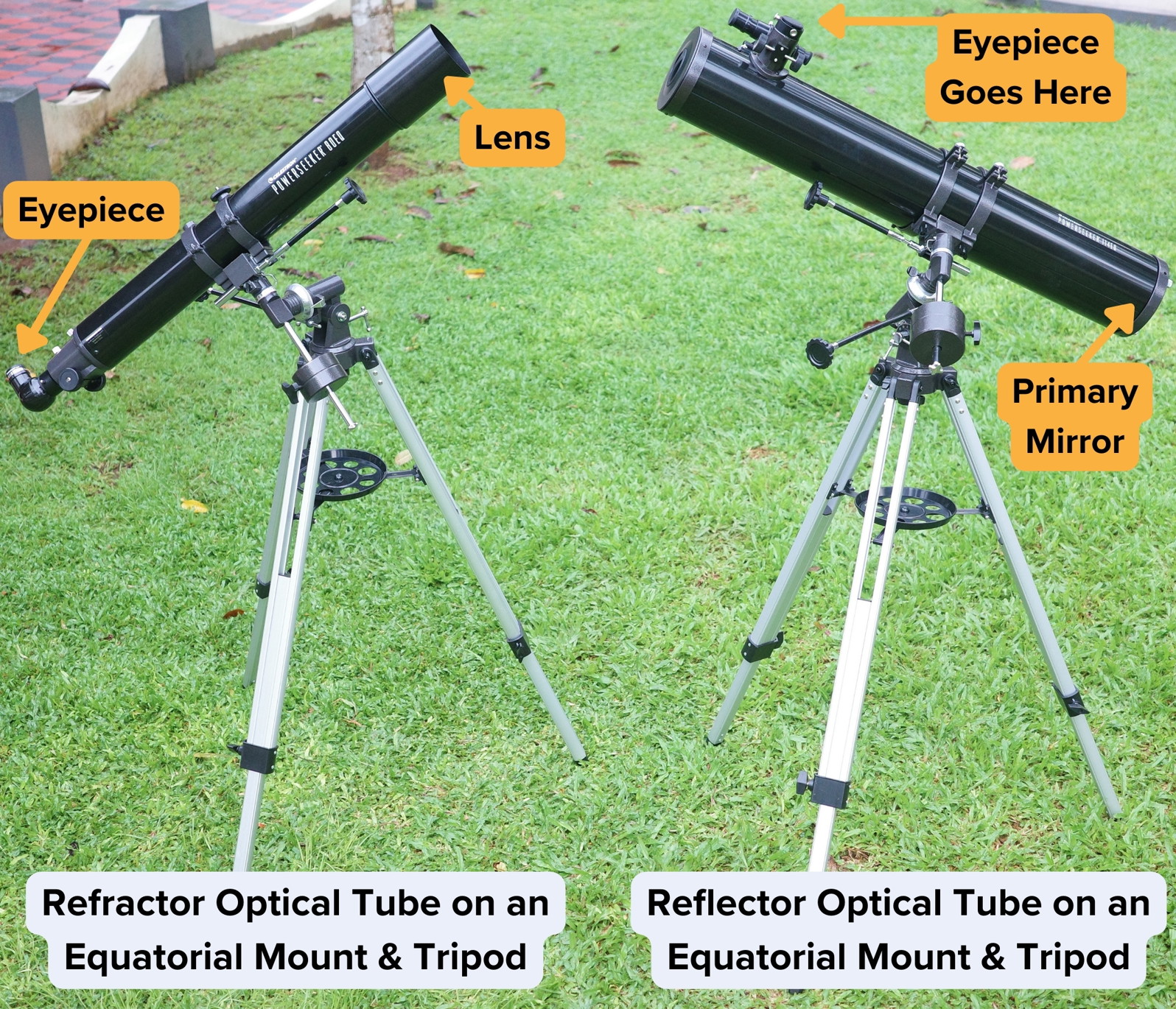
When I started looking for my first telescope years ago, I had an image in my mind of a long tube with a lens on one end and an eyepiece on the other. That describes a refractor telescope. Galileo made this type well-known in the early 1600s.
It’s only when I started shopping that I discovered there are also reflector telescopes based on mirrors rather than lenses. The mirror sits at the bottom of a tube and the eyepiece sticks out the side. This type was developed by Sir. Isaac Newton in the mid-1600s, and so it is often referred to as a Newtonian or Newtonian reflector.

I am going to address two questions and hopefully enable you to purchase the best telescope with confidence. Or, if you already have your first one, then I will help you prepare for that second purchase, as it is common for astronomy hobbyists, like myself, to have more than one telescope.
- Which is better for a first-time telescope buyer?
- What’s the difference between reflector and refractor telescopes?
First, let’s define some terms that I will be using.
- Aperture: The diameter of the front lens or the rear mirror in inches or millimeters. One inch equals 25.4 mm. For convenience, you can round that to 25. So if you think of a 4-inch aperture as 100 mm, you will be close enough for this discussion.
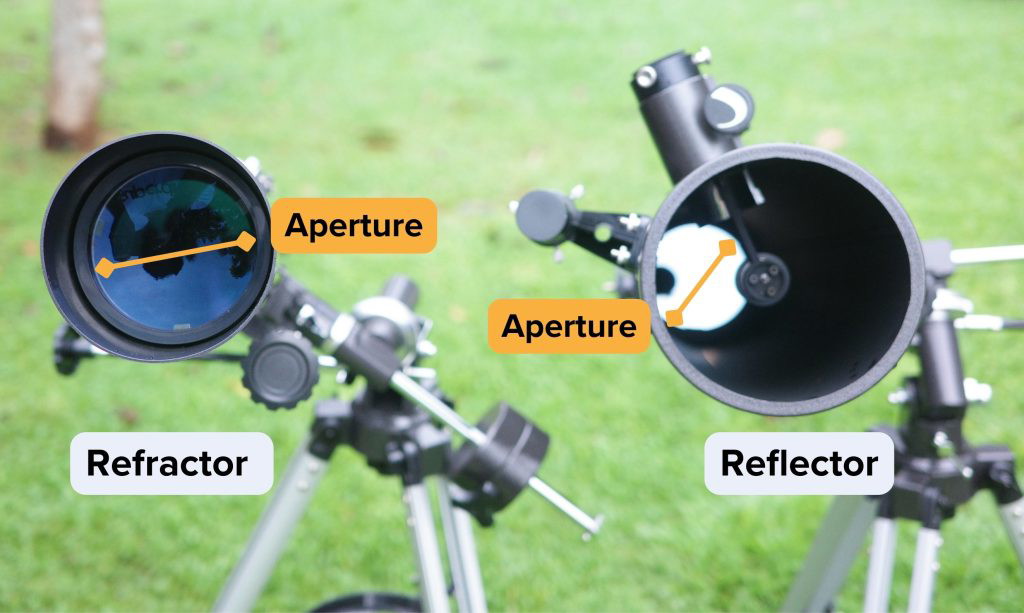
- Focal Length: The length of the path that the light travels in the optical tube.
- Focal Ratio: Focal length/aperture usually expressed as f/# such as f/5 or f/10
When we say telescope, we are really talking about two parts: the optical tube assembly and a mount. This discussion will focus on the refractor and reflector types of optical tubes only. Just know that there are various of styles of mounts (equatorial, altitude-azimuth, e.t.c) and either type of optical tube can go on any kind of mount. For this discussion, we will use ‘telescopes’ and ‘optical tubes’ interchangeably, assuming the optical tube is mounted.
- Refractor Telescope: The Basics
- Newtonian Reflector: The Basics
- Advantages and Disadvantages Of Each Design
- The Conclusion: No Clear Winner
Refractor Telescope: The Basics
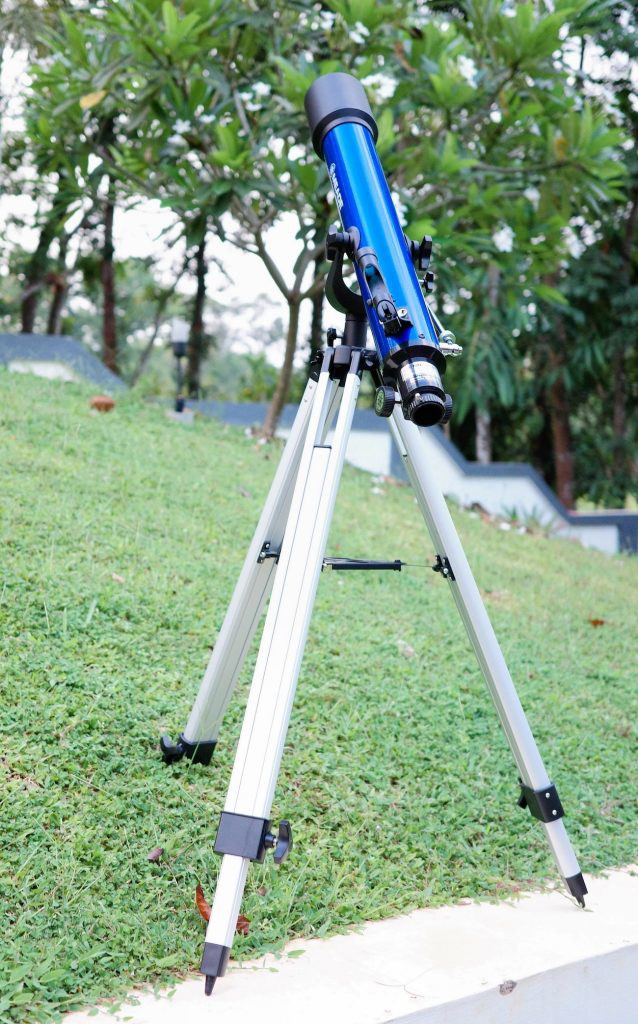
A refractor telescope has a curved lens on the front. As it gathers light, it bends it and concentrates it at a focal point within the optical tube.
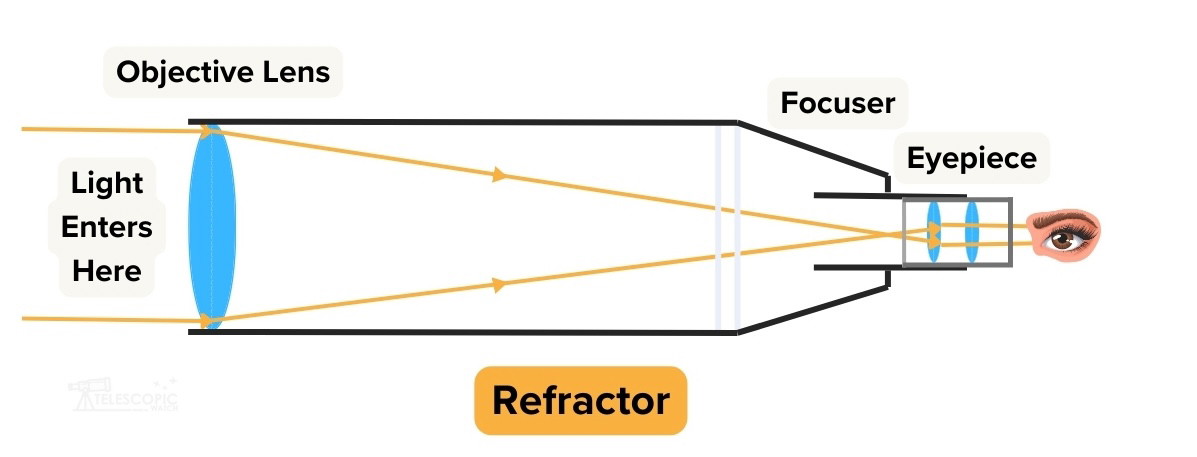
You could have an eyepiece directly in the path of the light, like a pirate’s spyglass. However, if the eyepiece were at the end of the tube and you had the telescope pointed high in the sky, you would have to be down on your knees to look through the eyepiece. Astronomical refractor telescopes usually have a diagonal in the light path that bends the light through a 90-degree angle to place the eyepiece at a more convenient position.
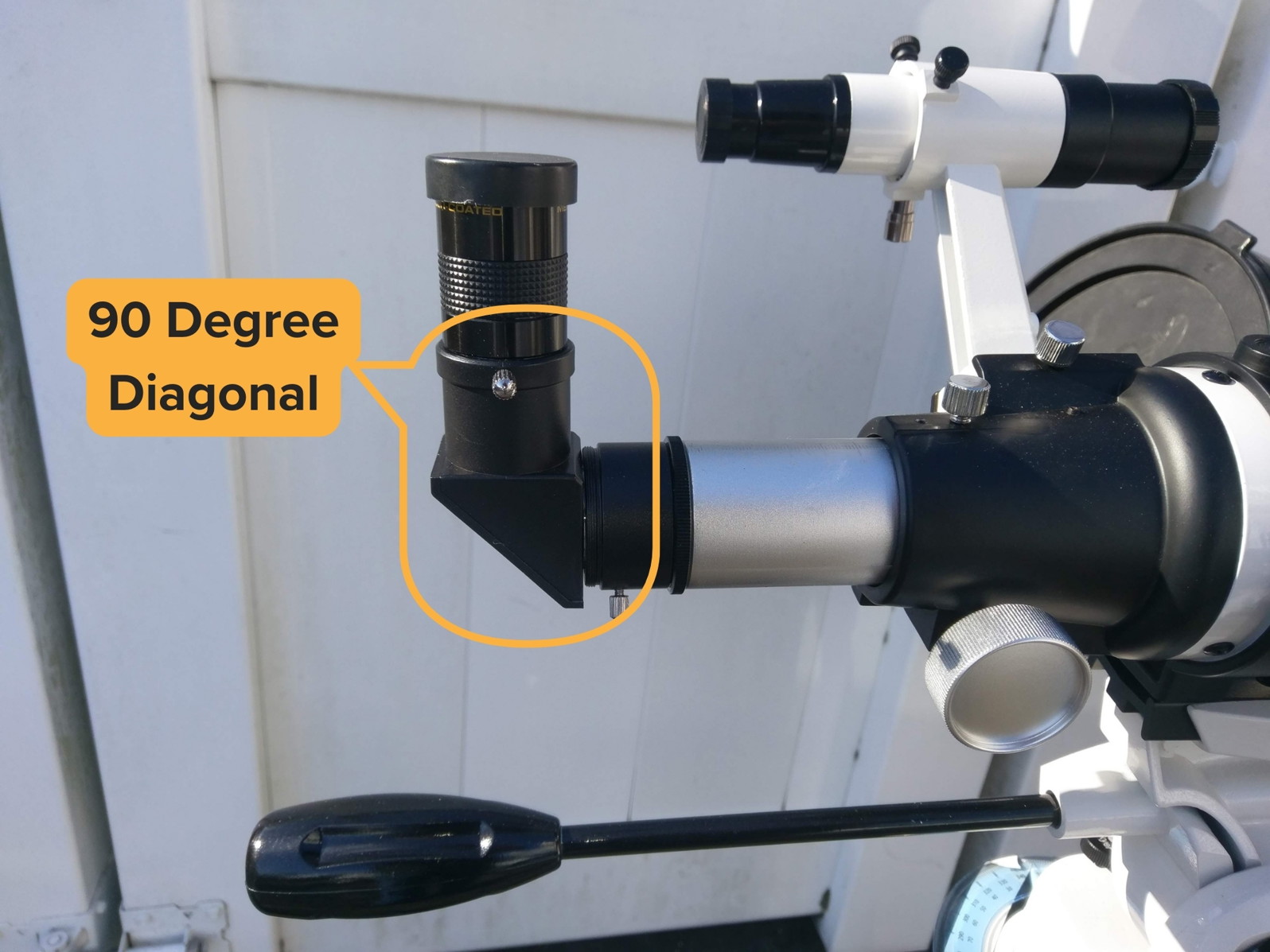
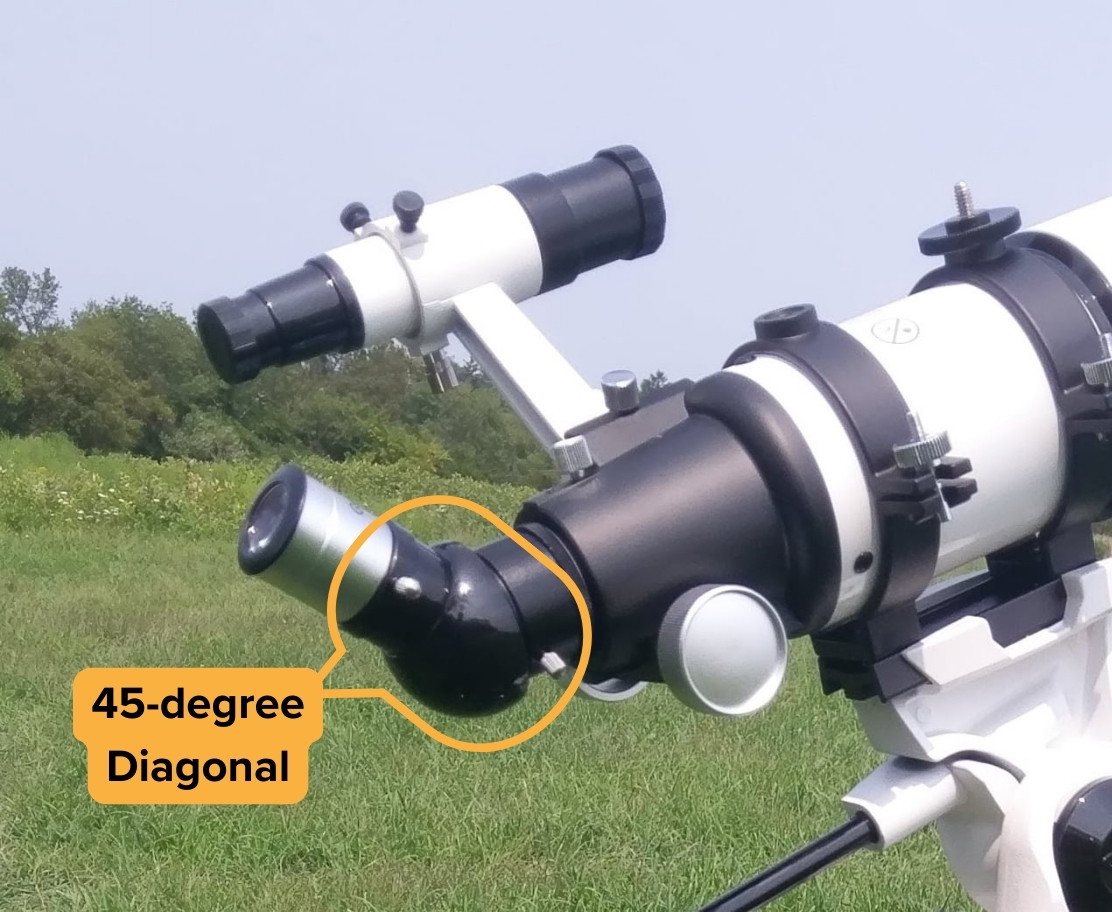
The eyepiece is usually then inserted into the diagonal. There are diagonals that use a 45-degree angle but these are better for daytime spotting scope use. For astronomy, you want a 90-degree “star diagonal”.
A refractor with a diagonal presents an image that is correct up and down but reversed left and right. For astronomy purposes, this left-right flip is of little importance as there is no left and right in space. If you want to use your refractor during the day to view boats on the lake or go bird watching, you can get a diagonal that has a prism to correct this left/right flip. This is how spotting scopes and binoculars are made, which are based on the refractor design.
Newtonian Reflector: The Basics
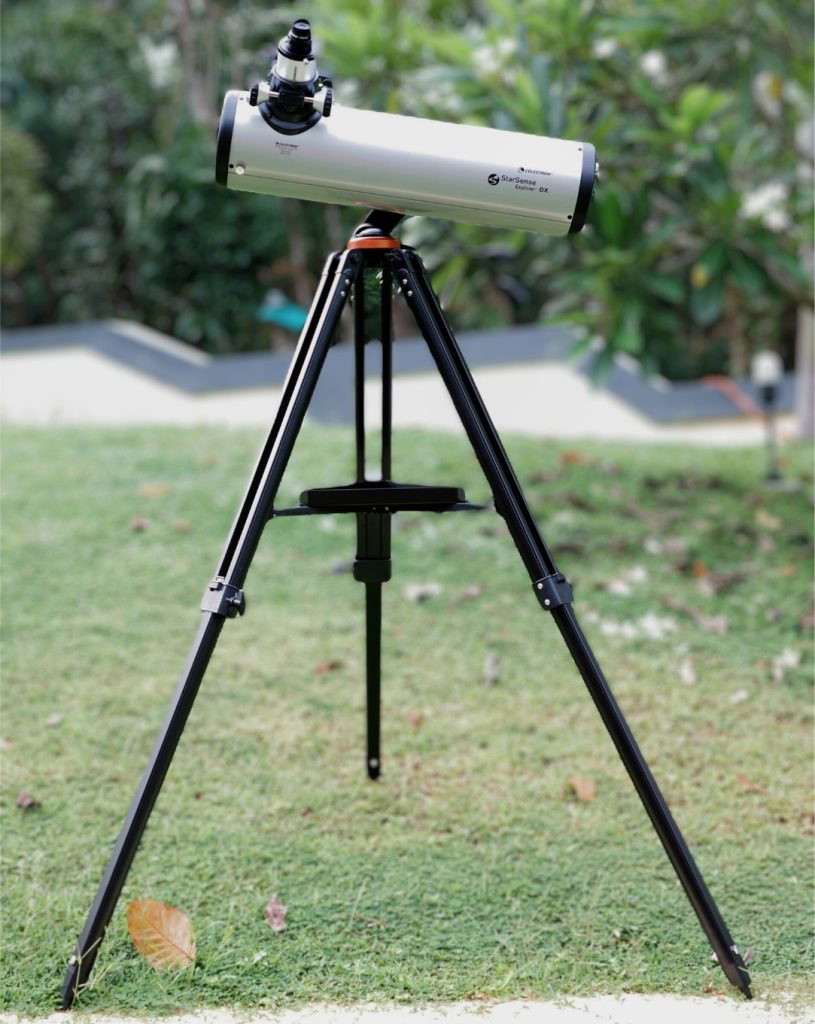
In this design, we have an open-ended tube, as seen in the picture below.
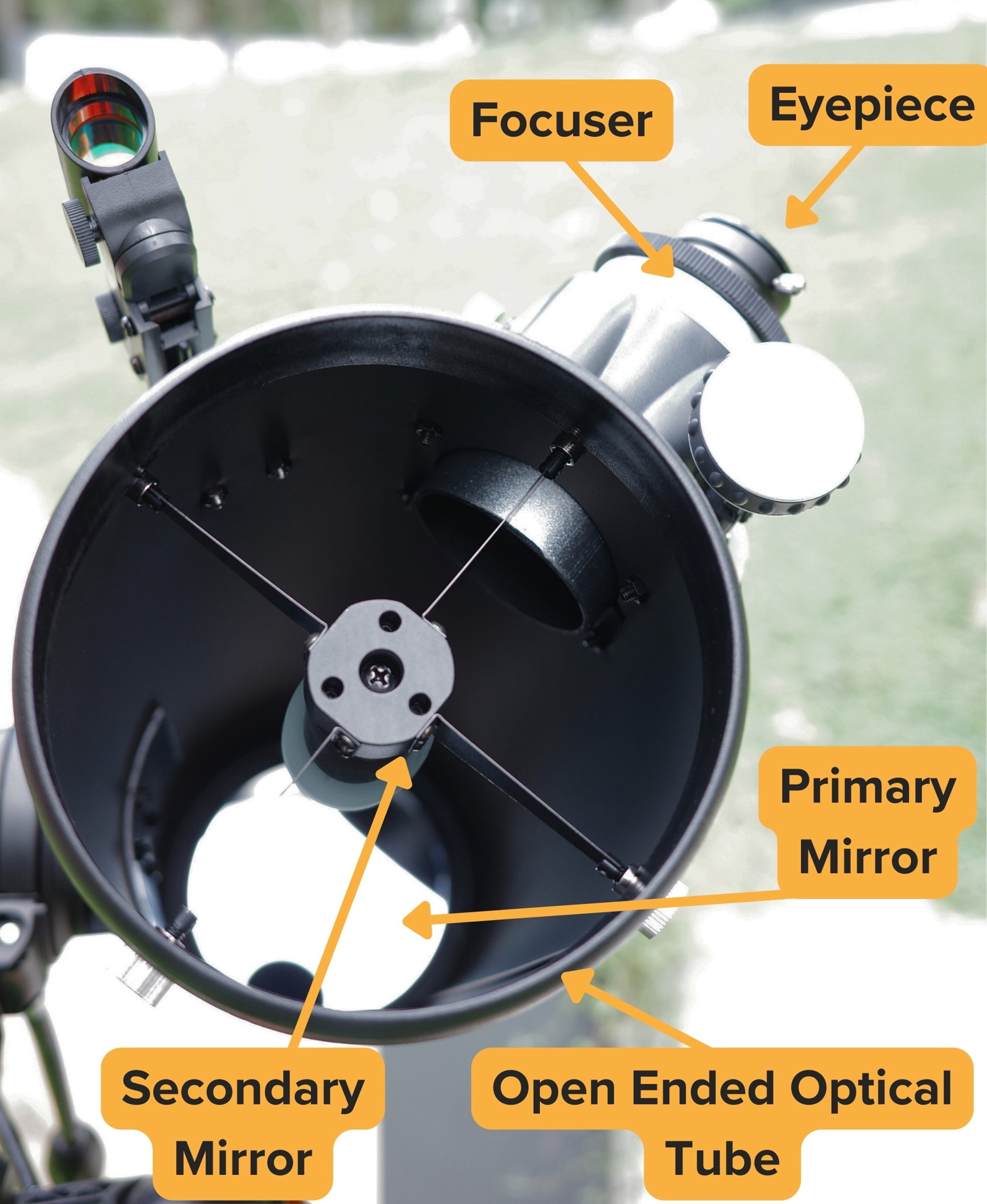
At the bottom of the tube is a curved mirror, called the primary mirror. This gathers the light from the sky and focuses it toward a flat secondary mirror that is set part way up the tube. This secondary mirror is set at a 45-degree angle so the light can be directed to the focuser on the side of the tube. The focuser holds the eyepiece. There is no diagonal, as the secondary mirror serves this purpose.
The reflector design produces an image that is inverted. This is not a big issue for astronomy purposes, although some people are bothered by it. However, this does render this type of scope impractical for daytime use. It would show the boats on the lake hanging upside down.
Scalability of Reflector Design
Since the Newtonian reflector’s primary mirror size is economical to scale up, you could easily find large aperture reflectors, which is not the case with refractors. Reflectors with a 16” aperture are common and those with a 25″ aperture are readily available. The largest privately owned reflector telescope has a 75” mirror, is mounted on a trailer and is pulled by a truck. But with higher apertures, the optical tube can also get quite long.
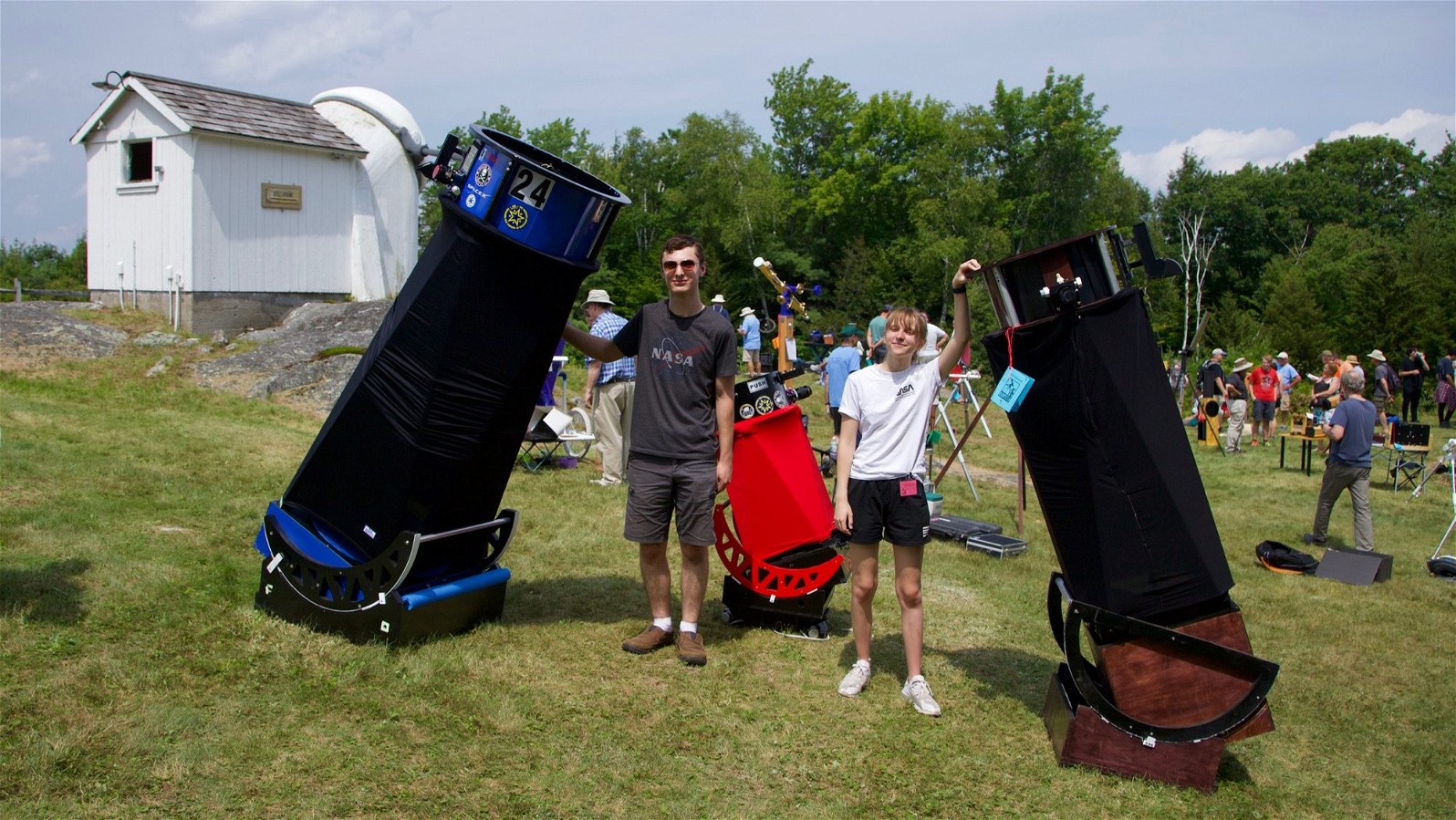
An 8” primary mirror that’s at a focal ratio of f/10 would need a telescope tube 80 inches long, or almost 7 feet. Clearly, this would not be a very convenient-sized telescope for the average person. So focal ratios of f/6 and lower are common. An 8” f/6 reflector would be about 48 inches long, which would fit in most cars.
As their aperture gets bigger, reflector designers often work to reduce focal ratios to keep the optical tube size manageable. Focal ratios of f/3 to f/5 are common in these big Newtonian reflectors. This would also be true for refractors but you simply don’t see them as big as reflectors.
Truss Tube Design in Reflectors
The second thing you see with Newtonian reflectors is truss design.
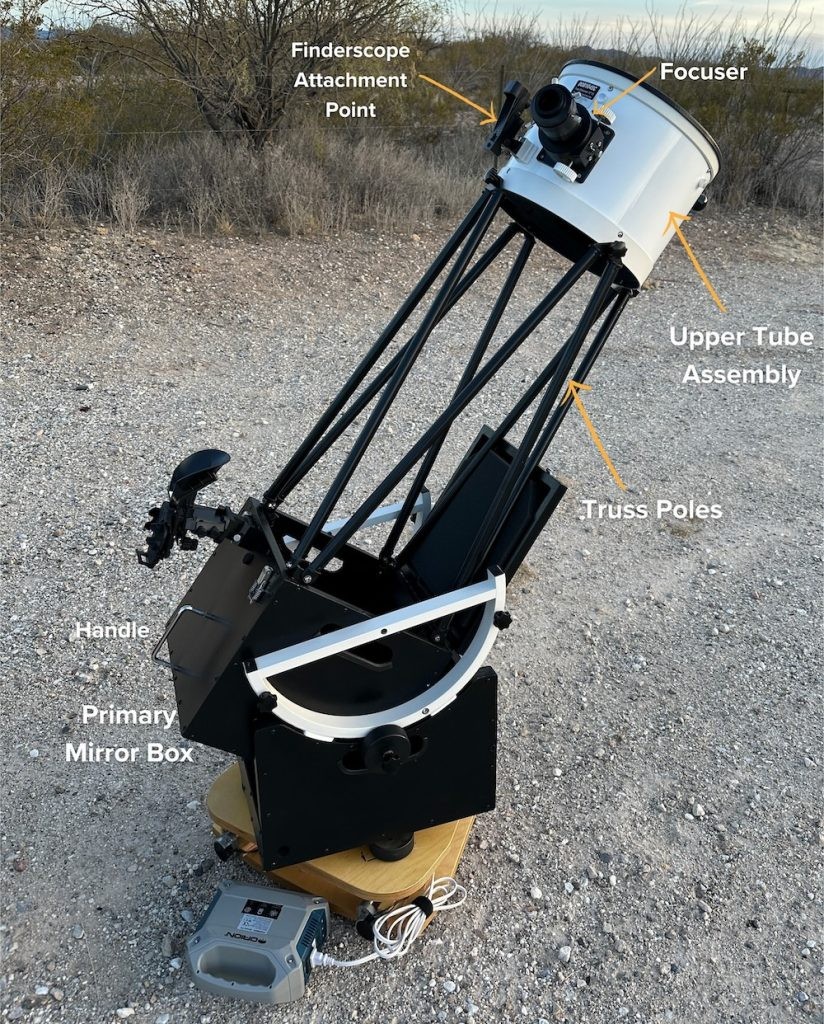
As shown in the picture, the solid tube is replaced with poles or struts. The primary mirror is contained in the box on the ground. The poles are attached to form a support for a ring where the secondary mirror, focuser, and finderscope reside.
The picture shows a Dobsonian-type mount where the mirror box sits on a rotating base and rockers so you can move it left and right, up and down, to point the telescope. If there is a lot of ground light, a shroud can be put over the framework to keep that stray light out of the light path.
Since a truss Newtonian reflector can be taken apart, you can get a huge telescope into your car, where a solid optical tube would need a trailer for transport. From my experience, a 14” truss Newtonian will fit in the typical sedan and a 25” truss Newtonian will fit in the typical SUV.
Advantages and Disadvantages Of Each Design
All optical devices represent a set of compromises. As such, there is no best design. Each has its strengths and weaknesses, advantages and disadvantages. I am going to get into the refractor vs. reflector debate so you can take these into consideration when you make your purchase.
Refractor Pros & Cons
- A key advantage of the refractor is that there is no central obstruction.
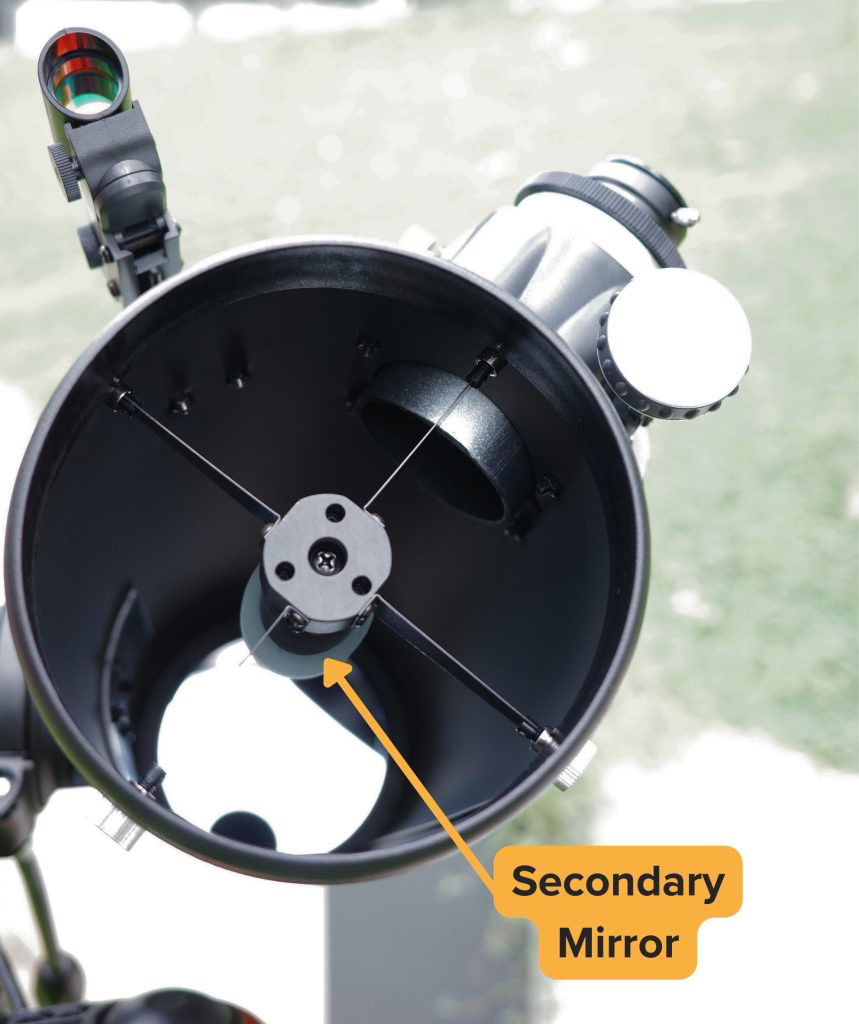
The secondary mirror of the reflector blocks some of the light coming into the tube, which reduces the effective aperture. In telescopes with a 5” or less aperture, the refractor is typically considered to have about a 1-inch advantage. This means that a 5” reflector and a 4” refractor would be considered about equal in light-gathering ability, a key measure of the power of a telescope.
This lack of secondary obstruction may also give the refractor a slight advantage in image sharpness. Naturally, this will depend, to some degree, on the quality of the manufacture of the telescope.
- Refractors tend to hold the alignment of the elements in the optical path because the front lenses are rigidly mounted.
Refractors are fairly maintenance-free, making them popular with new astronomers. This may be another reason that the refractor design is incorporated into binoculars and most spotting scopes.
- The primary disadvantage of the refractor is chromatic aberration or CA.
As light passes through the primary lens, it breaks up into its color components, just as a prism casts a rainbow on the wall by breaking white light into its various colors. As the light reaches the focal point, the various colors do not arrive at exactly the same time, creating a tendency to cause some color fringing on bright objects.
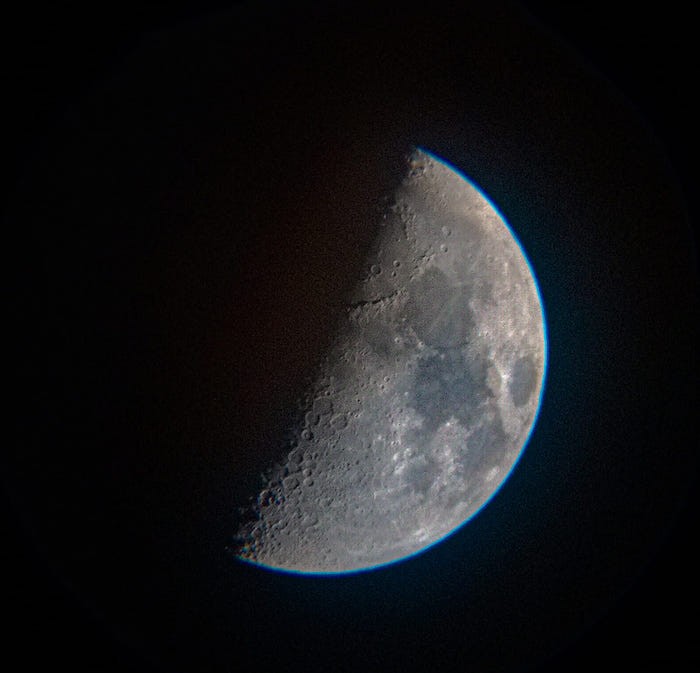
To address this chromatic aberration (CA), refractor designers have created two variations of the refractor.
The lower-cost refractor design is called an achromatic refractor, or sometimes a doublet due to the primary lens having two lens elements. This is the typical design seen in entry-level refractors. With two lens elements that are made of different glass, this type of primary lens can reduce the amount of chromatic aberration as compared to a single primary lens element.
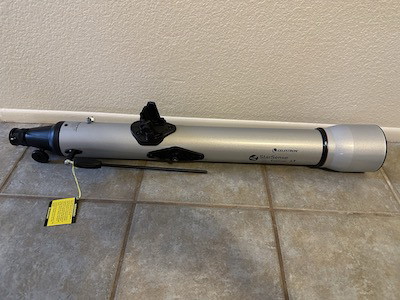
The smaller the focal ratio of the achromatic optical tube, the more chromatic aberration you are likely to see. The higher the focal ratio, the greater the reduction of chromatic aberration. An achromat with a focal ratio of f/5 will show some color fringing around bright objects, like the Moon. An achromat with a focal ratio of f/10 will show a lot less and f/15 may show almost none at all.
Achromats are usually for visual use, not astrophotography. Some people are bothered by the CA of low-focal-ratio achromats, while others hardly notice it. However, if you take a photo through the eyepiece of an achromat, you will likely see color fringing around the Moon and other bright objects.
The more expensive refractor design is the apochromatic refractor, also called an APO. Through the use of special glass and usually including an additional primary lens element, chromatic aberration is virtually eliminated in APOs. These are also often called triplets due to the third lens element. APO refractors are usually preferred by those engaged in astrophotography, where chromatic aberration would seriously compromise the image. However, they are more expensive and heavier than achromatic refractors.
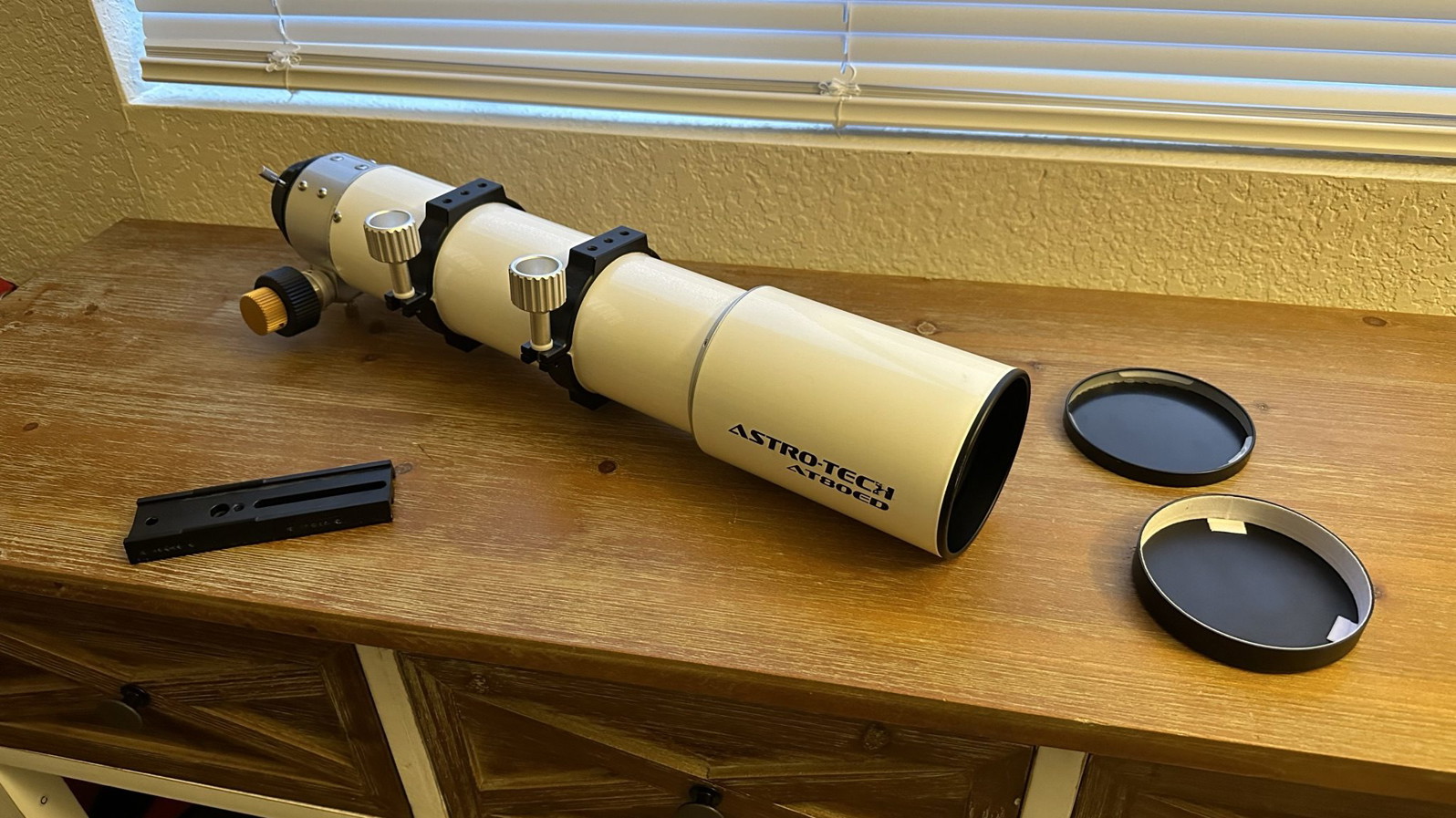
Newtonian Reflector Pros & Cons
- The advantage of the Newtonian reflector design is that it is less expensive to manufacture quality mirrors than lenses, especially as they get larger.
In the range of 2” (50 mm) to about 5″ (127 mm), the cost difference is not particularly noticeable. But when we get above 5″, this cost advantage starts to become apparent. In the hobby market, it is unusual to see a refractor larger than 8″, while Newtonian reflector designs easily scale to 25” and larger. Virtually all optical tubes larger than 16” are based on a reflector design.
Once you get past 6”, the Newtonian reflector is the king of price performance as measured by cost per inch of aperture. When mated with a low-cost Dobsonian mount, you get the best price-performance telescope on the market.
- With mirrors, there is no splitting of the light into its color components as you get with the refractor, so chromatic aberration is not an issue.
- Reflectors do introduce an aberration called coma, especially in lower focal ratio designs.
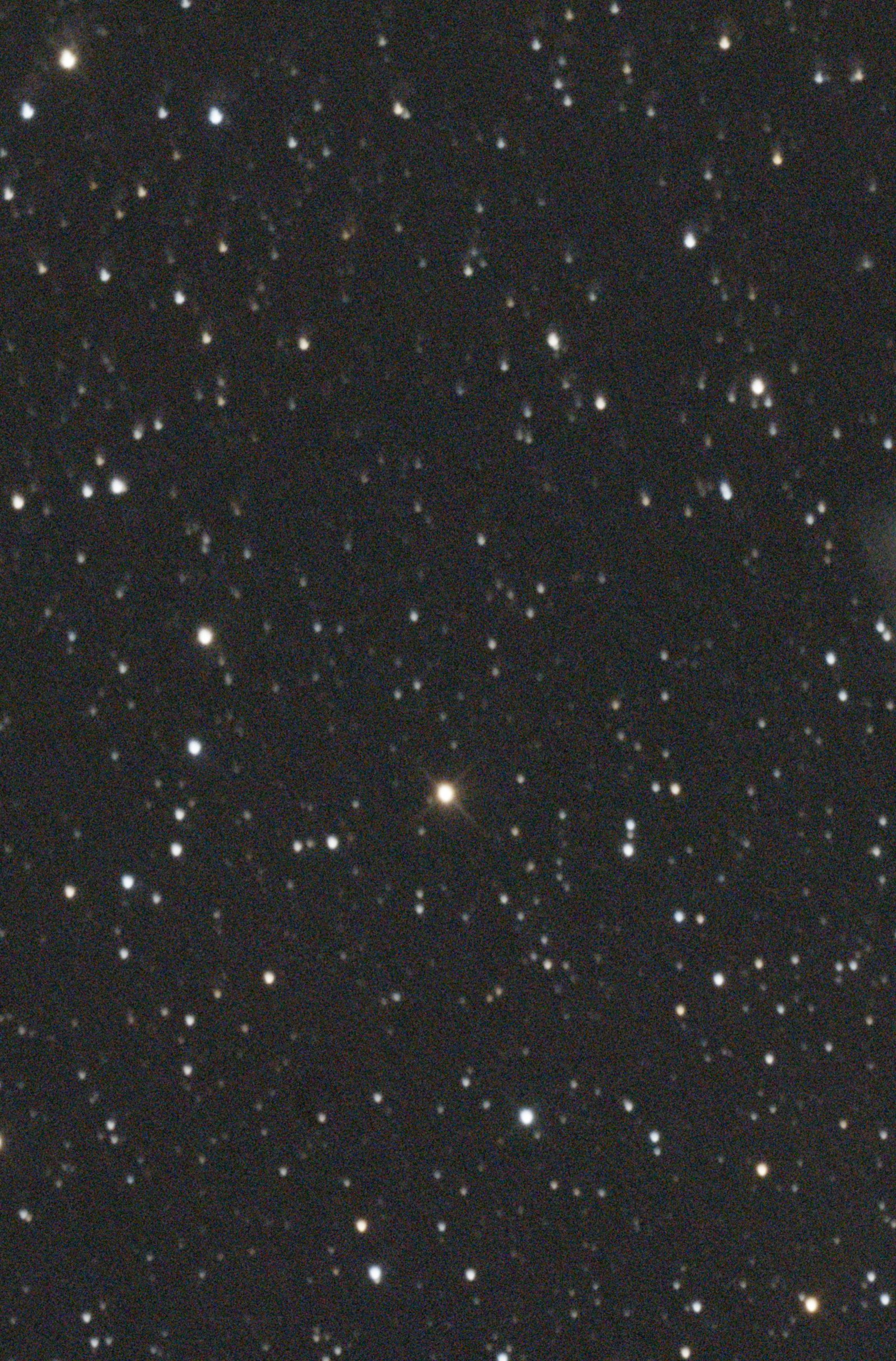
Coma results in stars that are near the outer edge of the field of view having a comet-like tail. In scopes that have a focal ratio of f/6 and higher, this is significantly reduced. Below f/5, an additional lens is often added to the light path to control or eliminate coma, which is called a coma corrector.
- The other factor with reflectors is the need for regular collimation.
The typical Newtonian reflector has a primary mirror that is mounted in such a way that the mirror can be moved to align the optics. The larger the mirror, the heavier it is and the more likely it is to be out of alignment due to bumps during transport. Additionally, the larger the mirror, the more it will be affected by thermal expansion and contraction, which can affect alignment. So there are adjustments incorporated.
To a lesser degree, the secondary mirror can also be put out of alignment. But because it is much smaller and lighter compared to the primary mirror, it is much less subject to loss of collimation. Still, it should be checked from time to time.
Collimation is a maintenance process that you will need to learn with most Newtonians over 4” in aperture. Some of the smaller ones have the primary mirror set permanently. But the larger aperture ones are usually adjustable. It is a simple procedure that only takes a few minutes once you have done it a few times. And it doesn’t have to be done every time you use the telescope. Still, some newbies shy away from reflectors for this reason.
The Conclusion: No Clear Winner
Either will serve you well. Both are available in low-cost packages and more capable packages for those with a higher budget. The more aperture you get, the more and dimmer things you can see in the sky. A larger aperture lets you apply more magnification and will reveal more detail. Naturally, as the size of the aperture goes up, the cost goes up and the weight goes up.
If you are looking for a scope of 4” or less and are concerned about learning collimation, a refractor is a good choice. They are easy to use and rugged. They travel well on family vacations and smaller ones can be carried in your carry-on luggage on a plane. If you add a 45-degree correct image diagonal, you can use a refractor as a daytime spotting scope. At night, you just switch to the 90-degree star diagonal, which is much better suited for astronomy. In this way, a refractor is more versatile.
If you want something larger than 4 inches, you will likely be looking at a reflector. The Newtonian design really becomes cost-effective at this size and larger. When mated to a Dobsonian mount, you have a very cost-effective solution that is rock steady and simple to use. If you go to a “star party” where people bring their telescopes, most of the larger ones are likely to be of the Newtonian/Dobsonian design.
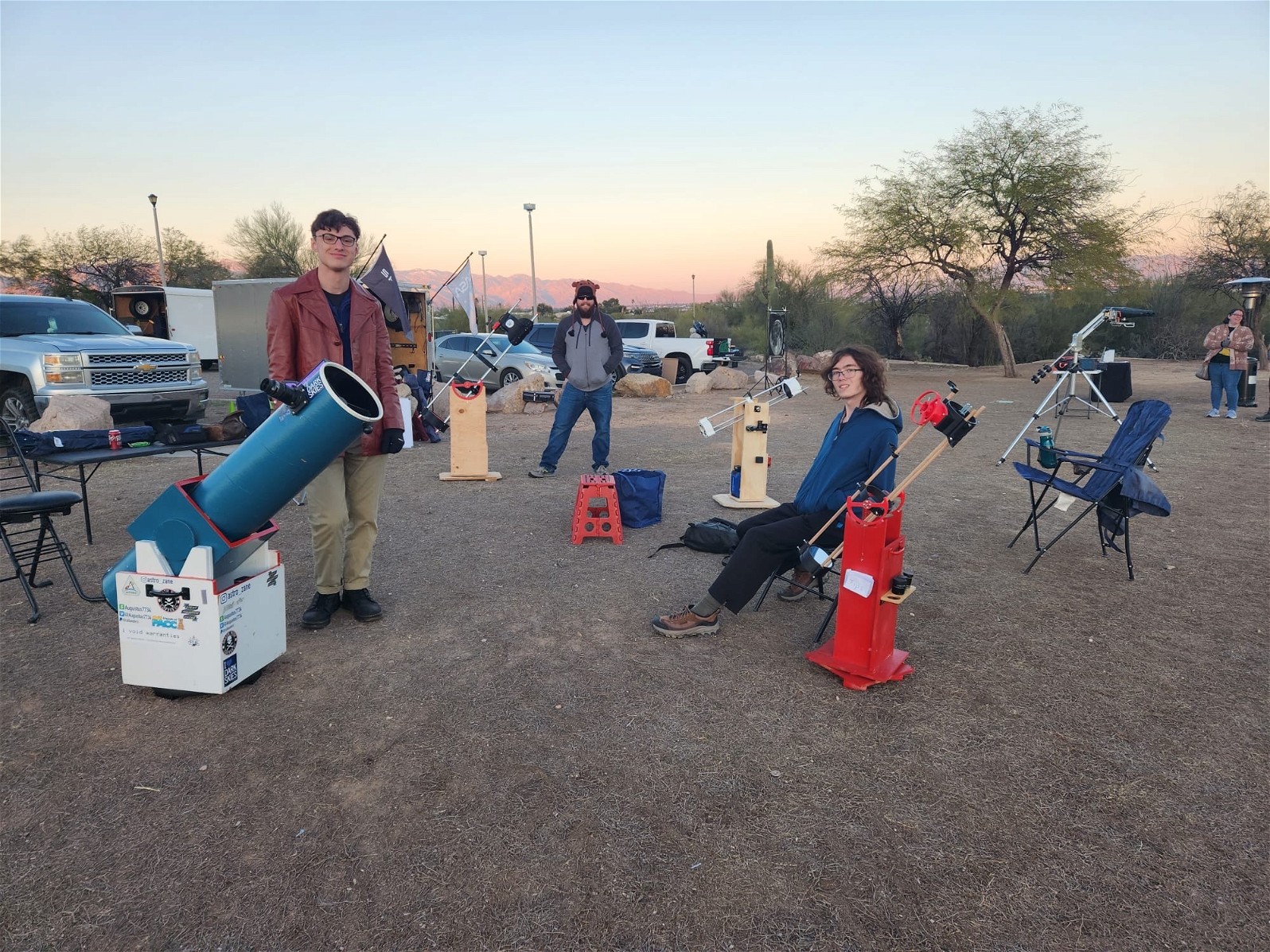
After years in the hobby, I have seen that those who pursue astronomy long term often end up with three types of visual-instruments:
- Binoculars (refractor)
- A grab and go, a lightweight scope that is easy to move and set-up. Typically, these are in the 70 mm to 130 mm aperture range.
- A light bucket – Typically something 8” (203 mm) or larger
So, your first optical device can be any one of these. As you go forward, you will likely add something in the remaining categories.

Ed
Thank you so much for these links. I have read most of these several times and my knowledge although limited at this time, thanks to you I feel a lot more confident about purchasing my first telescope.
Thank you for this article! I have been reading a lot of articles and yours has been THE most helpful in making a decision.